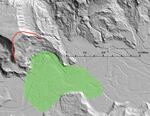
A preliminary map of the landslide area in northwest Washington.
U.S. Geological Survey
The last time the U.S. Geological Survey made a national map of landslide hazards, it did so on paper. It didn't use laser imaging for landslide detection and it didn't render the maps with high-powered geographic software near-universally used in today's maps.
It didn’t use these things because they didn't exist. It was 1982.
That’s how old the federal agency’s landslide overview map is, and it hasn’t been updated since. It lacks detail and the USGS will quickly warn you not to use it for planning purposes. The map assigns ratings to broad swaths based on what percentage of land was involved in a slide. It also includes susceptibility ratings that the documentation states are “largely subjective.”
After the deadly landslide in Northwest Washington last month, many are suddenly wondering why better maps don't exist they way they do for, say, flood risks.
Experts including those at the USGS have advocated for an updated system to track landslide hazards, but the agency lacks the resources. Using laser imaging, geologists are discovering more past landslides than ever. But they've applied that tool to only a sliver of the landscape.
“We have no overall federal-level regulation or mandate to do further landslide maps on a national basis--the explosion of technology and Geographic information systems that we have currently would make a national map much more complex, detailed and at least, up-to-date,” Lynn Highland, Coordinator of the National Landslide Information Center, wrote via email.
Oregon and Washington are ahead of other states in mapping landslides but their efforts have also lagged behind the tools needed to do the job. Ian Madin, chief scientist for Oregon’s Department of Geology and Mineral Industries (DOGAMI), estimated the state’s inventory is at most 25 percent complete.
Mapping Landslides
Using inventories from DOGAMI and the Washington Department of Natural Resources, EarthFix mapped known landslide deposits in the Northwest. The map also includes the old USGS hazard zones, what portions of the states have seen state-level landslide hazard studies and what parts of the states have been mapped with LIDAR. You can also search for your city or address (but landslide deposits won't show up at the furthest zoom).
The landslide deposits -- the dark brown blobs -- show times when the lands deposit shifted, which could be spread out over decades or centuries, according to Madin. The yellow and pink shaded areas behind it are the outdated USGS maps. You can toggle them on and off.
Oregon's inventory of landslide deposits comes from a patchwork of studies. Some are done specifically for geologic hazards. Others are done for mining or other purposes. The red "hazard-specific" patches on the map in Oregon show studies done specifically for geologic hazards.
Some are finely detailed. Others are broad brushes. This leaves some portions of the state showing more deposits than others, whether they’ve experienced more slides or not. It also shows dense packs of deposits cut off in squares -- a product of incomplete data, not modular landslides.
Oregon Department of Geology and Mineral Industries Map
showing the level of detail in landslide study areas.The
most detailed areas are in green, followed by blue,
then yellow and orange.
In Washington, the inventory consists of an older repository of landslides at one mapping scale, and a more detailed but less comprehensive inventory of landslides produced more recently as part of the DNR's "Landslide Hazard Zonation" project done for its forest practices division (there's a long-standing link between logging and landslides. Read about it here and here.) The bright red patches on the map in Washington show the areas for these hazard studies. Some counties and other local authorities also produce similar hazard maps, but they are not part of the state's inventory.
The most detailed landslide inventories come from LIDAR -- laser imaging that can cut past vegetation and reveal the ground below with unprecedented clarity. Geologists have found LIDAR can reveal several times the number of landslides that were previously known in a given area. Using LIDAR, geologists at DOGAMI estimate they've mapped more landslides in the past five years than in the previous history of the agency.
News coverage following the Washington landslide shed light on the need to connect the technology with planning.
State maps show less than half of Oregon and Washington have been studied with LIDAR, and somewhere around 5 percent or less of Oregon has been studied with the tool specifically for landslides. According to the DNR, none of Washington's state landslide inventory comes from LIDAR-produced data. Some counties in Washington use LIDAR for these purposes to a limited extent.
Editor's Note: This map shouldn’t be used for planning purposes. This map won’t tell you where to build your house if you want to avoid a landslide. It is an attempt to show the best available data, to illustrate what we know as much as what we don't. This map is not a complete inventory of landslide occurrences or hazards, because such mappable data don’t exist.
Related Links
- OPB's Think Out Loud: Clackamas County's Landslide Map
- NW News Network: Landslide Data Is Out Of Date


